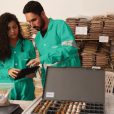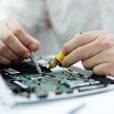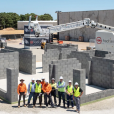The football player laying on the field clutching their leg might seem overdramatic until you read that the incidence of anterior cruciate ligament (ACL) tears is quite high – up to 10 injuries per 1,000 game hours, with the highest rates of injury reported in professional players.
Such an injury will sideline a player for a minimum of 4 months, in reality however, this often extends to 6-8 months. Ongoing long term sequelae such as osteoarthritis in the knee is common following recovery.
Surgery is required in many cases to accelerate healing and repair. The current gold-standard surgical procedure requires harvesting of an autologous tendon graft from the patient’s own hamstring and using that to reconstruct the ACL. This method weakens the donor hamstring tendon, opening up the patient to further injuries.
What about synthetics? Corin’s synthetic LARS ligament was a notable attempt to address donor site issues; however, the synthetic ligament has a failure rate of 1 in 3 patients, often causing further injury and requiring further surgeries. Small fragments of plastic from the device have been detected throughout the body following incidences of fatigue failure.
Once touted as the ‘miracle cure’ for ACL injuries, LARS was popularised in AFL circles a decade ago under the promise of players returning to the field within 3-4 months. Said popularity quickly faded when players returning from the accelerated LARS procedures quickly ruptured their ACL again, many of whose careers were then ruined.
Seeing the need for refinement and innovation in this space, regenerative medicine company Orthocell (ASX: OCC) has developed an alternative. Their CelGro collagen rope device is made from braided collagen fibres and is designed to function as an alternative to autologous grafts for ACL reconstruction thereby reducing donor tendon morbidities.
With over 15,000 ACL knee reconstructions being performed annually in Australia, and up to 200,000 in the US with many needing revision surgeries, CelGro could disrupt a USD $17.5 billion dollar market.
Orthocell has released promising pre-clinical study data indicating the novel CelGro collagen rope is a viable and effective method of ACL reconstruction. In a recent preclinical study led by Orthocell’s Chief Scientific Officer, Professor Ming-Hao Zheng alongside the University of Western Australia, the device performed well. CelGro collagen rope promoted ligamentisation and was found to mimic characteristics of the original ACL. The CelGro rope also integrated with the host bone tunnel, making it biomechanically comparable to usual hamstring graft.
Findings from this study are to be presented at the Australian and New Zealand Orthopaedic Research Society Annual Conference next month. The Company has plans to progress to larger animal preclinical studies before they enter first-in-human trials.
Managing Director of Orthocell, Paul Anderson said: “We are extremely excited by the potential of this new application for the CelGro platform. There are currently no biological off-the-shelf solutions that mimic native ligament to enable the optimal repair of ACL injuries and synthetic alternatives have been proven to be disastrous for patients. An “off-the-shelf” biological device that augments ACL reconstruction and is biologically compatible is highly desired by the orthopaedic industry and Orthocell is ideally placed to deliver the CelGro collagen rope in this rapidly growing and lucrative market.”
- Parkinson’s UK backs Pharmaxis with $5 million to slow the onset of incurable disease with ‘ground breaking’ trial - September 1, 2022
- How this company is developing medtech to support Indigenous community health - August 22, 2022
- A round of ap-paws for PharmAust, changing the ruff prognosis for dogs with lymphoma - August 17, 2022












Leave a Comment
You must be logged in to post a comment.